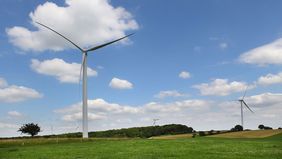
STEAG launches green energy campaign
Essen/Düsseldorf. The Essen-based energy company STEAG, in cooperation with Quadra Energy, is embarking on the marketing of green electricity. In that venture, STEAG is drawing on its extensive expertise in the field of energy trading with a view to concluding green power purchase agreements (Green PPAs) with operators of generation facilities based on renewable energy sources. STEAG will then use that energy to supply customers or feed into its own projects, for instance for the production of green hydrogen, which STEAG is planning together with partner companies at the Duisburg-Walsum and Völklingen-Fenne sites.
Whereas energy from renewable sources was previously marketed largely under the terms of the Renewable Energy Act (EEG) in Germany, the market share of green electricity has recently increased significantly. One reason for this is that the EEG funding for new plants is now significantly lower than in previous years. On the other hand, more and more renewable generation facilities are reaching the end of the subsidy period stipulated in the EEG, with the result that their operators are looking for marketing alternatives.
Green PPAs open up economic prospects beyond the EEG
“That’s where we and our partner QUADRA Energy come in,” explains Oliver Welling, who works in the Trading Division at STEAG and is responsible for the Green PPA business there. “We collect the renewables capacities from old and new plants that are no longer subsidized under the EEG regulations or never qualified in the first place, and then market them.”
Cooperation with experienced service provider
Project partner QUADRA Energy already has many years of experience in the field of energy management services for operators of renewable energy generation plants: “In addition to the direct marketing of electricity from renewable energy sources with an entitlement to subsidies, green electricity from wind turbines without any funding entitlement is one of our core products. For this purpose, we group together many individual and distributed generation facilities in a large wind pool. In this way, operators obtain a source of income which lasts beyond the subsidy period. QUADRA combines this financial security with bespoke technical plant service to create an all-round carefree package. We are pleased to supply STEAG with electricity from our wind pool,” says Dr. Thomas Krings, Head of Sales at QUADRA Energy.
The term of the electricity supply contracts that STEAG and QUADRA are now concluding with plant operators is based on the age of the plants. “In order to extend the service life of older, formerly subsidized plants and thus increase their profitability, we can additionally offer our contractual partners technical services from STEAG,” says Oliver Welling.
This mainly involves the artificial intelligence-based systems from STEAG subsidiary STEAG Energy Services for predictive maintenance of wind and photovoltaic plants. “Predictive maintenance is based on a continuous analysis of the operating data of the plants in real time, which provides information in the event of even the smallest deviations, enabling anticipatory intervention and thus averting damage to the plants before it can occur,” says Dr. Ralf Schiele, Director for Market and Technology at STEAG.
Green PPAs plus electricity storage result in major ecological and economic benefits
In addition to the direct marketing of green electricity and its use in the company’s own green hydrogen production, the Green PPA business creates a link to another STEAG project. “STEAG is planning to build an ‘Energy Cloud’ storage facility with a minimum energy storage capacity of 1,000 megawatt hours (MWh) and a capacity of around 250 megawatts (MW),” says Christian Karalis, who is the responsible project manager at STEAG. The option of storing green energy temporarily and then using it specifically when there is corresponding demand from customers reduces price risks even further.
But the interaction between Green PPAs and electricity storage has not only economic advantages, but also and above all ecological benefits: “Because supply and demand do not coincide, given the fluctuating nature of generation from wind and solar energy, the supply has to be buffered. This means that it can actually be used by the customer when it is needed. Otherwise, there is a risk of negative electricity prices, including the shutdown of plants for power generation from renewables. The storage solution can save some of this energy which would otherwise be lost,” explains STEAG storage expert Christian Karalis. In addition, customers can be supplied with green energy for many more hours, thus increasing the share of renewable energy overall.
Green PPAs are a contribution to a successful energy transition
Especially in combination with other technical measures, Green PPAs make an important contribution to the success of the energy transition: “Marketing green electricity in such a way that it is available when it is really needed on the market is an important step on the way to a successful energy transition,” says Ralf Schiele. Because that means a significantly better market integration of renewable energy sources than the Renewable Energy Act has been able to achieve so far. STEAG offers partners technical and energy management expertise from a single source It is precisely this combination of energy management expertise and plant engineering skills that engage in direct marketing: “By having additional options in the form of our hydrogen and storage projects to optimally market the electricity originating from the Green PPAs, we set ourselves apart well from pure electricity traders, because we can offer further stages of the value chain from a single source,” says Oliver Welling.
